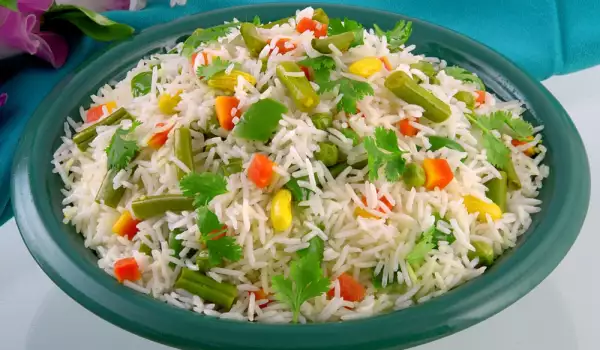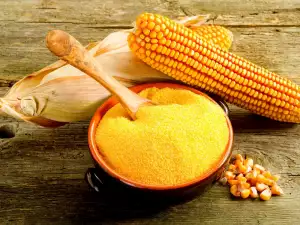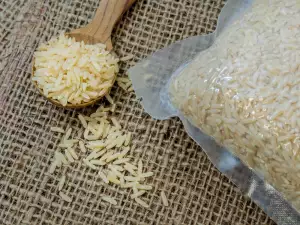Basmati rice is a variety of long grain rice with thin grains and a characteristic and very aromatic taste, suitable for preparing various exotic national dishes. We can find both white Basmati rice and whole grain Basmati rice.
In Hindi, the name basmati means "rich in incense" and comes from the Sanskrit vassaymayup (soaked in aroma). From Sanskrit its name became Vasumati and then Basmati.
It is widespread mainly in Asian cuisine, grown mainly in India and Pakistan and in some regions of the United States, but the best varieties are produced in the foothills of the Himalayas.
Basmati rice has 86 different varieties. The traditional Basmati from Dehradun is one of the most valuable varieties of this rice. It is grown in a valley bordering the Ganges and Yamuna rivers, using old technology without modern cultural tools and methods. The tools used by local farmers are almost basic (wooden sickles and plows) and the insecticides used are completely natural (ash and cow urine). Thanks to this adherence and fidelity to tradition, Dehradun rice is one of the most authentic forms of Basmati, a great example of the biodiversity that this rice has to offer.
Among the varieties classified as authentic, the most important are the following: Punjab, Dehradun, Safidon, Kasturi, Haryana, Pusa, Puk.
Characteristics of Basmati rice as a healthy food
Basmati rice has the advantage of being an important source of carbohydrates for our body and at the same time having a low glycemic index, unlike other types of rice, even when it is not whole grain.
As with other varieties of rice, Basmati rice is completely gluten-free, so its consumption is suitable for those who suffer from celiac disease or those who need to temporarily avoid gluten-containing foods.
Basmati rice is low in fat. Among the mineral salts that it brings into our body, we find above all potassium. It is also a source of fiber, especially in its whole grain version. Basmati rice is also easy to digest and very nutritious.
According to Ayurveda, Basmati rice is the king of rice and is generally part of the sattvic foods that bring energy and nourish the body without weighing it down.

Nutritional values of Basmati rice
Let's find out what are the nutritional values of Basmati rice are, in order to include this food in your diet in a balanced way. The following nutritional values correspond to 100 g of boiled Basmati rice:
Protein 8 g
Carbohydrates 78 g
Sugar 0.05 g
Fat 0.89 g
Saturated fat 0.09 g
Monounsaturated fats 0.122 g
Polyunsaturated fats 0.122 g
Cholesterol 0 g
Fiber 0.4 g
Sodium 126 g
Potassium 32 g
When it comes to calorie intake, keep in mind that 100 g of boiled Basmati rice carries about 340-350 calories to our body depending on the variety.
Glycemic index of Basmati rice
The glycemic index of the rice can be very high, especially if it is plain refined rice, but in the case of Basmati rice the glycemic index is average, equal to 53 for white Basmati rice and 45 for whole grain Basmati rice.
Keep in mind that plain white rice has a high glycemic index, even higher than 80, while Basmati rice has a lower glycemic index, because it is richer in amylopectin, a substance that helps prevent levels of blood sugar from rising sharply.
Basmati rice in cooking

Basmati rice actually has a unique flavor that surpasses any other variety of rice. Its aromatic flavors refer to jasmine and above all to sandalwood, a very valuable Indian essence.
Basmati's second characteristic, on the other hand, relates to cooking behavior. The grains of this rice with their typical sword shape do not remain the same as in the raw version, but grow and lengthen to double their volume compared to their original size. In addition, at the end of cooking, the grains remain firm and well separated from each other. This quality makes Basmati ideal for typical oriental cuisine preparations, where rice is not used for risotto preparation and rice soups, but as a bread substitute, as an addition to meat or fish dishes.
Preparation of Basmati rice
To prepare Basmati rice well, you will need to boil it in boiling water with a pinch of salt. Basmati rice cooking time varies from 10 to 30 minutes, depending on whether it is white or whole grain. To be sure of the cooking time, always check what is written on the package.
As with any type of rice, Basmati rice is recommended to be rinsed briefly before cooking to remove any impurities.
Due to its intense aroma, Basmati rice is excellent as part of fish dishes or meat and vegetable dishes, enriched with salt, aromatic herbs and spices such as curry, paprika, turmeric and black pepper.
Basmati rice with its characteristic taste is perfect for the preparation of Indian and Oriental dishes. In fact, you can season it with vegetables, nuts and spices of your choice, including ginger, cinnamon, cumin and coriander. Basmati rice is also suitable as rice for special risotto.
With Basmati rice you can prepare many classic rice recipes by replacing ordinary rice with it: boiled rice, stewed rice, risotto, rice soup, rice cream, rice pudding, rice salads, stuffed vegetables with rice (zucchini, peppers, tomatoes, etc.), arancini rice, rice balls, Cantonese rice, etc.
Exotic recipes with Basmati rice

Basmati rice pilaf
Basmati rice can be prepared with the pilaf technique, which consists of cooking the rice in a pan, drizzling it with broth and boiling it, covered and without stirring at all. This Turkish way of cooking can be done in the oven and on the stove. What will show you, if the rice is ready, is the degree of moisture: when it is dry, you can serve it. Thanks to the fat they absorb during baking, the grains separate well. For every 100 g of rice you will need to add 200 ml of water.
You will need onions, which should be finely chopped and placed in a pot with a lid (the cookware should also be able to enter the oven). Add 50 g of butter to soften the minced meat over low heat. At this point, add the rice and while stirring at all times, bake it for 3-4 minutes, until the grains are translucent and they separate.
Heat the broth and slowly pour it over the rice, by stirring. At this point, increase the heat and bring the liquid to a boiling point, by stopping to stir. Cover the dish and place it in a preheated oven at 200°C. Your pilaf will be ready in 18 minutes. Remove the lid: if the grains are completely dry, then your rice is ready. Add a few flakes of butter and then mash with a fork. To make it tastier, you can make Basmati rice pilaf with curry vegetables.
Basmati rice with carrots, peas and cashews
Necessary products for 2 servings: 180 g Basmati rice (white or whole grain), 100 g fresh peas, 750 ml lightly salted water or vegetable broth, 100 g carrots, 50 g cashews, 1 pinch of ground ginger, paprika, black pepper, 1 pinch asafetida (optional), 2 teaspoons cumin seeds, 2 tablespoons olive oil.
How to prepare it: To make this Basmati rice recipe, you can use white Basmati rice or, better yet, whole grain rice. Keep in mind that whole grains have a longer cooking time, so check the instructions on the package carefully. Peel and wash the carrots and cut them into cubes. Blanch them along with the fresh peas for 5 minutes. Prepare 750 ml of slightly salted water or vegetable broth, obtained according to your habits. Bring everything to a boiling point in a pot. In a large skillet, pour 1 tablespoon of olive oil and heat it briefly. Pour the Basmati rice and cook it for about 1 minute, by stirring gently with a wooden spoon.
Then add a ladle of water or broth to the rice and add the spices. Add another ladle of boiling water or vegetable broth and add the carrots and peas into the pan. Continue to add water or broth, as for the preparation of normal risotto. The cooking time is about 15 minutes for white Basmati rice and about 35 minutes for whole grain Basmati rice. When the rice is almost done, heat a small pan in which you can toast the cashews for a few minutes. At this point, when the rice is cooked, all you have to do is season with one or two tablespoons of olive oil, add the toasted cashews, season with salt and black pepper, stir and serve.
Cantonese rice - the original recipe
Ingredients: 200 g Basmati rice, 1 onion, 6 tablespoons peanut butter, 250 g peas, 1 tablespoon soy sauce, 125 g boiled ham, 3 eggs, oil, salt by taste.
Preparation: Boil the rice in salted water, stew the peas with a little oil by adding hot salted water, until it's cooked. Cut the onion and divide it into two parts. Beat the eggs with the salt and half the onion, heat two tablespoons of oil, add the egg mixture and stir, transfer into a plate and finely chop it. When the rice is cooked (before it becomes mushy), strain it, stew it for a minute with two tablespoons of oil, the other half of the chopped onion and soy sauce. Stew the ham and peas with salt and oil, mix the ingredients and stew on low heat for a few seconds.

Basmati rice arancini
Ingredients for 4 servings: 180 g Basmati rice, 2 sachets of saffron, 200 g minced meat mixture, 100 g boiled peas, 60 g carrots, 60 g onions, 40 g celery sticks, 50 g grated Parmesan cheese, 20 g white wine, broth by taste, salt and black pepper by taste, 10 g olive oil, 1 egg, frying oil, egg and breadcrumbs for breading.
Preparation: Cut the vegetables into small pieces and dry them in olive oil. Add the minced meat, after frying, deglaze with white wine and leave it to evaporate. Season with salt and black pepper. Add the rice and boil it in the sauce, by adding a little hot broth, if necessary. 5/10 minutes after the end of cooking add the saffron, which has been dissolved in a bowl of hot broth. Add the peas, then mix with the grated cheese. Leave the rice to cool. Add the egg, then shape the arancini with your hands. Bread the arancini in the lightly beaten egg, then in the breadcrumbs. Fry in plenty of hot oil and strain, once a golden color is obtainied, onto kitchen paper. Serve hot.
Vegan rice cream
Necessary products for 1 serving: 40 g Basmati rice, 200 ml almond milk, cinnamon or vanilla according to taste, 1/2 banana, 1 tsp. peanut butter, sweetener according to taste.
Preparation: Put the almond milk (according to taste with a pinch of cinnamon and / or vanilla) in a pot, leave it to boil and cook the Basmati rice in it for 10 minutes (or in any case according to the time specified in your packaging). When it is well cooked, let it cool and then blend with a blender. Adjust the creaminess to your liking, by possibly adding more milk or water while mixing everything. Pour it into a glass and refrigerate it. Serve it with sliced banana, peanut butter and sweetener of your choice. Of course, you can garnish the cream with what you like best: fresh fruit, dried fruit, chocolate, honey, nuts, jam.




















Comments